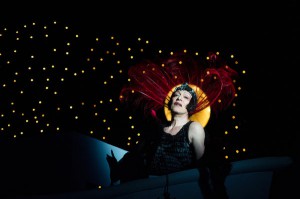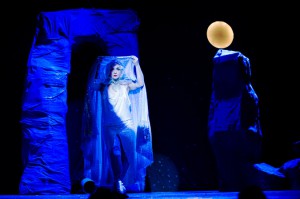By Rachel Straus
The Martha Graham Dance Company’s 90th anniversary season (April 14-18) at New York City Center opened with Graham’s Night Journey (1947) and closed with her Cave of the Heart (1946). In between these masterworks, about Greek tragedy heroines, was a world premiere by the experimentalist Marie Chouinard and the last proscenium work that the venerable Swedish choreographer Mats Ek said that he would ever make. Considering that Chouinard’s Inner Resources reads like an uninspired group of teenage competition dancers trying to look avant-garde and Ek’s Axe was both terrifying and beautiful, it is a tragedy that Ek will not be making more dances for the stage and that Chouinard will.
Axe (2015) was created on Ben Schultz and Peiju Chien-Pott, the most dramatically daring and physically chameleon-esque Graham dancer of her generation. Axe is about a couple in crisis. It was originally made by Eks as a film, featuring his wife and dancing muse Ana Lugana. At City Center, the dance begins with the sound of a heavy object falling, again and again. When the curtain goes up, Schultz wields an ax. He is splitting wood on a tree stump. In the course of the nine-minute ballet, set to a recording of the Albinoni-Giazotto Adagio in G minor, Schultz obsessively chops wood into smaller and smaller pieces—like a woodsman with a compulsive disorder. Because the music has been used in innumerable tragic films, including Gallipoli (1981), we know that this dance is not going to end well. Indeed, Schultz never looks up to notice a haggard Chien-Pott, teetering side to side, like an unsteady piece of brittle wood. She circles around Schultz, but he pays no mind. So Chien-Pott becomes increasingly manic, repeatedly falling to the floor, and extending her legs to all four corners as if trying to dislocate her limbs. Their tragic story, however, has a surprise ending: the petite female dancer fills Schultz’s enormous arms with wood and marches him to the wing. As the curtain falls, Chien-Pott raises the ax—it’s aimed at his head.
Graham (1894-1991) would likely have approved of Axe. It features all of the elements that made her 1940s masterworks radical and potent: a revenging female dancer, a movement vocabulary that sallies between the grotesque and the sublime, a compressed abstracted story, and a large muscular man who is easy on the eyes, and when given a chance, is shown to be a good dancer too.
Since the Graham company’s current mission is to commission choreographers to make works that bear a relationship to Graham’s oeuvre, it is nigh impossible to understand Chouinard’s Inner Resources as bearing any aesthetic relationship to Graham’s. It possesses the quality of an amateur music video, with its half-hearted Vogueing and some clumsy b-boy floor moves. The music by Louis Dufort, who has collaborated with Chouinard since 1996, produces the effect of listening to a DJ club mix that is inside of a food processor. The women upend the heteronormative by sporting big mustaches, but they also strut on the points of their feet like runway models. When they strip off their blue shirts and black pants, they stand inert as if their nudity makes them afraid to move. This last image isn’t exactly a feminist statement. The Graham company’s eight female dancers deserve better than this.
Fortunately, the performance of Cave of the Heart, with Chien-Pott playing the revenging Medea, salvaged the company’s image that night. The Mannes Orchestra, under the baton of David Hayes, supported the dancers in their ability to breathe life into the work’s dramatic personae. Chien-Pott, Abdiel Jackson, Anne O’Donnell and Leslie Andrea Williams’ artistic courage, and inventiveness, made this Graham ballet relevant and worth repeat viewings.

